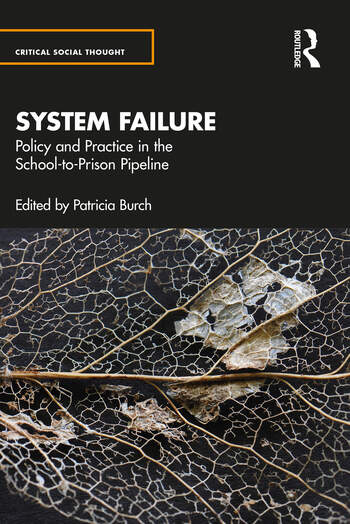
System Failure: Policy and Practice in the School-to-Prison Pipeline
Edited By Patricia Burch
SYSTEM FAILURE provides a framework for understanding the ways in which education policy across organizational settings contributes to the school-to-prison pipeline, as documented in the literature and as observed by authors in empirical studies of justice-involved youth in regular public schools, juvenile court schools, probation settings, and alternative schools. Burch and contributors argue that education policy fails low-income justice-involved youth in three major ways: maintaining silence around issues of structural racism and civil rights, marginalizing youth voice and culture and language, focusing on schools or the criminal justice system, and overlooking intermediate settings including the role of for-profit and not-for-profit education companies. While the problem of the school to prison pipeline has been well documented, the book adds critical detail and description of a policy process that tolerates the school-to-prison pipeline and stalls efforts to abolish it.
The book is intended for educators, students, policymakers and practitioners interested in a comprehensive introduction to the policy issues as well as advocates doing serious work on the issues.
Education Review: Turner, E. O. (2020). Suddenly diverse: How school districts manage race & inequality. University of Chicago Press.
Reviewed by James C. Bridgeforth University of Southern California United States
Recent projections from the National Center for Education Statistics (NCES) demonstrate clear racial and ethnic demographic shifts underway in U.S. public schools. In stark
contrast to the racial composition of public
schools in the early years of the 21st century,
NCES projects that by the year 2029, White
students will comprise 44% of the total
population of public-school students (National
Center for Education Statistics, 2020). As
school districts across the nation grapple with
the realities of their changing racial
demographics, Erica Turner’s book, Suddenly
Diverse: How School Districts Manage Race &
Inequality, provides an in-depth, comparative
case study of how leaders in two diversifying
districts in Wisconsin navigated their duty to
meet the needs of all students and families.
The school districts featured in Suddenly
Diverse should be familiar to U.S. readers, as
they exemplify popular notions of a changing
America that is regularly portrayed in the
media. Turner describes Milltown as “a city
with a struggling economy and a less inclusive
attitude toward immigrants and people of
color” (p. 164). In fact, a Milltown school board member explained that the county
where Milltown is located previously
attempted to make English the community’s
official language (p. 1). It is a town, like many
across the Midwest, that has historically
identified as a fairly conservative, racially
homogenous community of White, workingclass citizens. To be clear, this ahistorical
characterization by Milltown residents denies
the impact of settler colonialism that has
violently displaced scores of Indigenous
people from these very lands. Nevertheless,
Milltown is portrayed as a picture of smalltown Middle America “where the first
question residents ask each other is ‘Where did
you go to high school?’, followed by ‘Where
did your grandparents go to high school?’” (p.
2).
In contrast to Milltown’s conservative,
working-class identity, Fairview is described as
a decidedly more liberal city, with a friendlier
outlook on its growing racial and ethnic
diversity. In 1963, prior to the passage of the
federal Civil Rights Act, city leaders passed a
local ordinance codifying protection against
discrimination on the basis of race, color,
religion, or national origin (p. 19). Fairview has
even enacted legislation qualifying it as a
sanctuary city by protecting undocumented
community members from discriminatory
harassment due to their lack of U.S.
citizenship. Anchored by “dominant economic
sectors of education and government, typically
less susceptible to changes in the economy”
(p. 19), Fairview is positioned as a progressive
city primed to welcome the impending
changes in its racial and ethnic composition.


